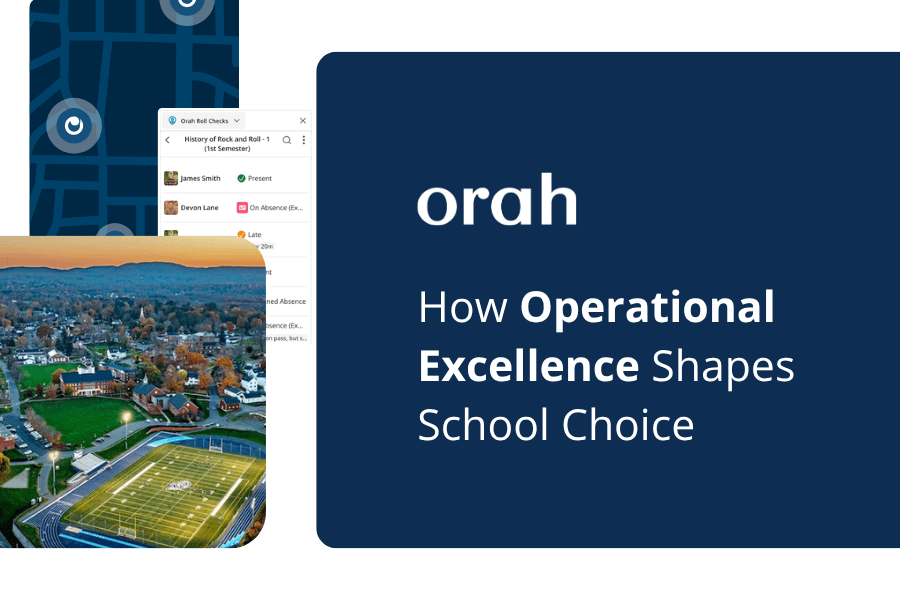What Models of Research Are Orah's Student Well-being Tools Based On?
Tiago Penteado
•
December 5, 2023

Orah’s Well-being Tools are grounded in an array of models and research, each contributing to a nuanced understanding of student's social and emotional well-being that schools can take advantage of.
In this article, we will highlight the bodies of research that Orah has used when developing these tools and provide you links to explore each model in more detail. We cover the following models:
Contributing Models of Research
- Circumplex Model of Affect
- The Flourish Model
Influencing Models of Research
- The RULER Approach
- PERMA Model
- EPOCH Model
- Hauora Well-being Framework
There are 101 Ways to Measure Well-being
First, we understand that schools around the world have an array of perspectives on what is most important to a student's growth, development and well-being. In acknowledgement of this, we have built our well-being tools to be customizable by default.
While the Orah Mood Checks™️ tool is firmly grounded in the Circumplex Model of Affect, it is customizable to cater to a student’s developmental stage and cultural & religious contexts. Orah’s Conversational Surveys tool features templates the school can use out-of-the-box to benchmark and understand the well-being of their students (the most prominent being our “Flourish Model” template), but we allow schools to build their own to get the picture of well-being that best aligns with their values. Our flagship free tool, Orah Notes, allows school staff to log behavioral & conduct notes about students & generate quick, accurate reports.
Together, these make up the Orah Nurture Health & Well-being module.
Contributing Models of Research
Without further ado, here are the models of research that Orah’s well-being tools are based on:
Circumplex Model of Affect
This model forms the basis of the Orah Mood Checks™️ module. It is a two-dimensional circular space encompassing arousal and valence dimensions.

The Circumplex Model of Affect suggests that all affective states arise from cognitive interpretations of core neural sensations, which are products of two independent neurophysiological systems. Emotions are placed in a circular order in a space formed by two bipolar dimensions: pleasure-displeasure and arousal-sleepiness.
Effectively, the Circumplex Model of Affect helps us understand emotions by combining two main ideas: how pleasant or unpleasant they are (valence) and how energized or calm they make us feel (arousal). Unlike other theories that say each emotion has its own unique brain system, this model suggests that emotions come from how we interpret basic feelings in our brain. It's like a map for emotions, where each one is placed on a circle based on these two factors. This model is useful in many areas, like studying how people with Autism Spectrum Disorders perceive emotions, and it helps in understanding different emotional conditions.
Learn more about the Circumplex Model of Affect
Orah Mood Checks™️
The design of the Orah Mood Checks™️ tool adheres to research firmly grounded in the Circumplex Model of Affect and the RULER approach. The Circumplex Model of Affect postulates that moods can be broadly measured across two dimensions - Energy and Pleasantness.

Orah Mood Checks™️ allows schools to automatically prompt their students to regularly submit Mood Checks™️, so they can track their moods and influences – helping students to develop & grow their emotional intelligence muscles.
Student Outcomes for School Using Orah Mood Checks™️
Based on the research outlined above and observations from within schools who use Orah, schools that conduct Mood Checks™️ with students can expect to see a range of the following student outcomes:
Improved Emotional Awareness
Students become more aware of their emotions and how to express them appropriately.
Better Emotional Regulation
There's an increase in students' ability to manage and control their emotional responses.
Enhanced Academic Performance
As students learn to manage their emotions better, this often leads to improved focus and academic success.
Increased Empathy and Understanding
Students develop a better understanding of their peers' emotions, fostering empathy and stronger social connections.
Reduction in Negative Behaviors
With improved emotional regulation and understanding, there's often a decrease in incidents of bullying and other disruptive behaviors.
Improved Classroom Climate
Overall, classrooms can become more supportive and engaging environments, conducive to learning and positive interactions.
Learn more about Orah Mood Checks™️
The Flourish Model for School Well-being
This model is presented as a free template within Orah's conversational surveys module.
The Flourish Model for School Well-being, developed by the Flourish Project (Wendy Ellyat) in collaboration with Harvard researchers, is an innovative approach to enhancing school well-being. This model is grounded in Barrett's Seven Levels of Consciousness, Maslow's hierarchy of needs, and systems science (source).
The Flourish Model conceptualizes well-being as a dynamic, interconnected process involving the individual, others, and the natural world. Additionally, the model aligns with Bronfenbrenner's ecological framework, highlighting the interplay between students, adults, and the broader community. Although still in its nascent stages, this model is a promising tool for positive education, integrating insights from leading researchers in the field.

It proposes an 'Ecology of Well-being' focusing on the natural, healthy development of young children and the well-being of current and future generations. The Flourish Model integrates the new Science of Child Development with adult-focused work from various researchers and emphasizes seven core aspects of human flourishing, including security, relationship, independence, engagement, fulfilment, contribution, and ongoing growth.
Learn more about the Flourish Model
Orah Conversational Surveys
Orah’s Conversational Surveys allow schools to benchmark, measure & better understand the well-being of their students.

Using the Orah apps on mobile or desktop, students are prompted to answer the questions put forward by the school in a conversational format. This format results in higher response and completion rates when compared to traditional survey tools.
It has the added benefit of being integrated into the student’s Orah experience, so it is a familiar space for most students.
Schools can build their own surveys, or use our research-backed survey templates to measure whole-school well-being.
Get started with the Orah Flourish Model Survey template
Orah Notes for Behavior Management
The free Orah Notes tool allows teachers, educators & school staff to log and categorize notes on the go, allocate house points, mark notes as sensitive or add a student to a 'watchlist' to escalate and securely share with your team.
Some schools use Orah Notes to allocate ‘Student Bucks’ as a reward for positive behavior, allowing students to “cash-in” at the end of the term.

Orah Notes allows educators to stay on the pulse of student conduct in the classroom, and enlist help from colleagues, families and students when needed.
Orah Notes for Report Writing

Orah uses these notes logged by teachers and staff to generate instant accurate student progress reports as often as you need them – allowing teachers & school leaders to write reports 10x faster, or for school leaders to get a quick pulse on student conduct at your school.
Influencing Models & Bodies of Research
The following models & research influence the work that Orah does, but is not directly attributable to any particular part of Orah’s product. They informed how we approached and considered wellbeing in the context of adolescents in an educational setting, and so they are outlined here.
It is also possible to build your own Orah Conversational Survey to align with one of these well-being models if you prefer a particualar model.
Mood Meter – The RULER Approach
The RULER approach is an evidence-based approach to social and emotional learning (SEL) developed at the Yale Center for Emotional Intelligence. It was created by Marc Brackett, who is the lead developer of RULER. RULER supports entire school communities in understanding the value of emotions, building the skills of emotional intelligence, and creating and maintaining a positive school climate. The approach teaches emotional intelligence to people of all ages, with the goal of helping them use their emotions wisely, opening opportunities for success in school, at work, and in life.

Similar to Orah Mood Checks™️, the Mood Meter developed by the RULER programme is also based on Circumplex Model of Affect which measures mood on two dimensions - (Activation) Energy, (Pleasantness) pleasantness.
RULER is an emotional intelligence program aimed at people of all ages, focusing on recognizing, understanding, labelling, expressing, and regulating emotions. The Mood Meter tool specifically enhances self- and social awareness and supports the development of a nuanced emotion vocabulary.
Learn more about the evidence for the RULER Approach
PERMA-V Model (Dr. Martin Seligman)
The PERMA-V model outlines the characteristics of a flourishing individual. It includes five components pursued for their intrinsic motivation and contribution to well-being: Positive emotion, Engagement, Relationships, Meaning, and Accomplishments. This model distinguishes itself by including both eudaimonic and hedonic components, thus offering a comprehensive perspective on well-being.
The PERMA Model was developed by positive psychologist Professor Martin Seligman (2011).
Here are the five essential elements of well-being identified:
- Positive Emotion: Experiencing happiness, joy, gratitude, and other positive emotions.
- Engagement: Being fully absorbed and involved in activities, also known as being in a state of flow.
- Relationships: Having positive and meaningful connections with others.
- Meaning: Having a sense of purpose and direction in life, and feeling that what you do is valuable and worthwhile.
- Accomplishments: Setting and achieving goals, and experiencing a sense of competence and mastery.
- Vitality: Research shows us that vitality is integral to our well-being. Our ability to sleep deeply, eat well and exercise regularly has a significant impact on all other elements of well-being. Maintaining physical vitality is essential for building resilience and bouncing back through adversity and challenge.
The PERMA-V model is part of Well-being Theory (WBT), where each dimension works together to predict the flourishing of individuals, groups, communities, organizations, and nations (source). It is a descriptive, not prescriptive, model, meaning it does not tell people what choices to make or what to value, but rather provides a framework for understanding the factors that contribute to well-being (source).
The model has been widely used in positive psychology and has been the foundation for various interventions aimed at increasing well-being and happiness.
Learn more about the PERMA-V Model
EPOCH Model (Dr. Peggy Kern)
An adaptation of the PERMA model, the EPOCH Measure of Adolescent Well-being focuses specifically on adolescence. It assesses five positive characteristics - engagement, perseverance, connectedness, optimism and happiness - that relate to good health and well-being.
The EPOCH Model was developed by Peggy Kern, an Associate Professor at the University of Melbourne in collaboration with Dr. Larry Steinburg. The model consists of five dimensions of well-being:
- Engagement: Refers to the extent to which adolescents are engaged and involved in their daily activities, including school, hobbies, and other pursuits.
- Perseverance: Captures the ability of adolescents to persist and maintain effort in the face of challenges and setbacks.
- Optimism: Reflects the extent to which adolescents hold positive expectations for their future and maintain a positive outlook on life.
- Connectedness: Refers to the quality of adolescents' relationships with their family, peers, and community.
- Happiness: Captures the overall life satisfaction and happiness of adolescents.
The EPOCH Model is designed to provide a comprehensive and holistic assessment of adolescent well-being, taking into account both positive and negative aspects of well-being.
Learn more about the EPOCH Model
HAUORA (Māori Philosophy)
Hauora is a unique Māori philosophy of health, encompassing physical, mental, family, and spiritual dimensions. It explores the interconnectedness of these dimensions and their influence on overall well-being.
Hauora comprises following four dimensions of well-being: Taha tinana (physical well-being), Taha hinengaro (mental and emotional well-being), Taha whānau (social well-being), and Taha wairua (spiritual well-being).

Each of these dimensions influences and supports the others, and all four dimensions are necessary for strength and symmetry. The Whare Tapa Whā model, developed by Dr. Mason Durie, compares Hauora to the four walls of a whare (house), each wall representing a different dimension.
The model is designed to provide a holistic understanding of health and well-being, taking into account the physical, mental, emotional, social, and spiritual aspects of well-being. The Hauora Model is widely used in New Zealand, particularly in the education sector, to promote well-being and positive health outcomes for Māori and non-Māori alike.
Orah for Student Well-being
Each of these models and research approaches contributes to the multifaceted structure of the Orah Well-being modules, providing a well-rounded and culturally sensitive approach to understanding and improving student well-being in educational environments.
Discover how Orah's Well-being Tools can transform your school's approach to student wellbeing. Dive deeper into the research, understand the models, and see the positive impact on your students. Get started for free today to explore the tools and start your journey towards a more nurturing and emotionally intelligent educational environment.
Prefer to talk to someone? Get a demo of Orah
Download your guide to knowing where students are
When you sign up, we'll send you a guide detailing what it takes to setup your daily operations to maintain student location awareness using your routine school processes like attendance, student leave, late arrivals, early dismissals & emergencies. You'll also recieve an invite to join the Orah community and get the quarterly newsletter.














